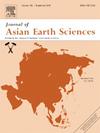Examining trace elements of cassiterite as fingerprints for tectonic settings of tin deposits: An example from the SE Asian tin province
IF 2.7
3区 地球科学
Q2 GEOSCIENCES, MULTIDISCIPLINARY
引用次数: 0
Abstract
Southeast Asia is a major global tin province and consists of three metallogenic belts: the Eastern, Central, and Western belts, which formed in oceanic subduction, continental collision, and post-subduction extensional settings, respectively. This study applies machine learning (eXtreme Gradient Boosting and SHapley Additive exPlanations) to cassiterite trace element data from SE Asia to identify key fingerprint elements and/or element ratios that distinguish these settings. Significant differences in Ti/Hf, Zr/Hf, Sc/Hf, Ti/Fe, and W/U ratios were observed, aligning with machine learning results. Compiling geochemical data from ore-forming granites in the three belts indicates that the elemental composition of cassiterite is closely linked to the geochemical characteristics of the corresponding granites. In the Western belt, mantle degassing contributed to highly evolved, fluorine-rich granites, producing cassiterite with the lowest Ti/Hf, Zr/Hf, and Sc/Hf ratios. The Central belt granites, derived from a reduced crust in a collision setting, enriched fluids in divalent Fe, leading to cassiterite with the highest Ti/Fe ratio. The Eastern belt, associated with fewer W-bearing minerals, shows higher W/U ratios due to limited tungsten depletion in ore-forming fluids. Using these five fingerprints, linear discriminant functions distinguish the three belts with 87% accuracy. Our findings indicate that the volatile content, differentiation, and oxygen fugacity of magma vary with tectonic settings and significantly influence the trace element composition of cassiterite. Therefore, this evolutionary pattern, from tectonic settings to magma properties and ultimately to tin mineralization characteristics, suggests that cassiterite may serve as an effective indicator for determining the tectonic setting of tin deposits.
锡石微量元素作为锡矿构造背景指纹的研究:以东南亚锡省为例
东南亚是全球锡矿大省,由东、中、西三个成矿带组成,分别形成于大洋俯冲、大陆碰撞和俯冲后伸展环境。本研究将机器学习(eXtreme Gradient Boosting和SHapley Additive exPlanations)应用于来自东南亚的锡石微量元素数据,以识别区分这些设置的关键指纹元素和/或元素比率。观察到Ti/Hf、Zr/Hf、Sc/Hf、Ti/Fe和W/U比率的显著差异,与机器学习结果一致。对三带成矿花岗岩地球化学资料的整理表明,锡石的元素组成与相应花岗岩的地球化学特征密切相关。在西带,地幔脱气作用形成了高度演化的富氟花岗岩,形成了Ti/Hf、Zr/Hf和Sc/Hf比值最低的锡石。中央带花岗岩形成于碰撞环境下的还原地壳,富含二价铁流体,形成Ti/Fe比值最高的锡石。东带含钨矿物较少,成矿流体中钨的损耗有限,W/U比值较高。利用这5种指纹,线性判别函数区分出3种带,准确率为87%。研究结果表明,岩浆的挥发性含量、分异和氧逸度随构造环境而变化,对锡石的微量元素组成有显著影响。因此,从构造环境到岩浆性质,最终到锡矿化特征的演化模式表明,锡石可以作为确定锡矿床构造环境的有效指示物。
本文章由计算机程序翻译,如有差异,请以英文原文为准。
求助全文
约1分钟内获得全文
求助全文
来源期刊

Journal of Asian Earth Sciences
地学-地球科学综合
CiteScore
5.90
自引率
10.00%
发文量
324
审稿时长
71 days
期刊介绍:
Journal of Asian Earth Sciences has an open access mirror journal Journal of Asian Earth Sciences: X, sharing the same aims and scope, editorial team, submission system and rigorous peer review.
The Journal of Asian Earth Sciences is an international interdisciplinary journal devoted to all aspects of research related to the solid Earth Sciences of Asia. The Journal publishes high quality, peer-reviewed scientific papers on the regional geology, tectonics, geochemistry and geophysics of Asia. It will be devoted primarily to research papers but short communications relating to new developments of broad interest, reviews and book reviews will also be included. Papers must have international appeal and should present work of more than local significance.
The scope includes deep processes of the Asian continent and its adjacent oceans; seismology and earthquakes; orogeny, magmatism, metamorphism and volcanism; growth, deformation and destruction of the Asian crust; crust-mantle interaction; evolution of life (early life, biostratigraphy, biogeography and mass-extinction); fluids, fluxes and reservoirs of mineral and energy resources; surface processes (weathering, erosion, transport and deposition of sediments) and resulting geomorphology; and the response of the Earth to global climate change as viewed within the Asian continent and surrounding oceans.
 求助内容:
求助内容: 应助结果提醒方式:
应助结果提醒方式:


